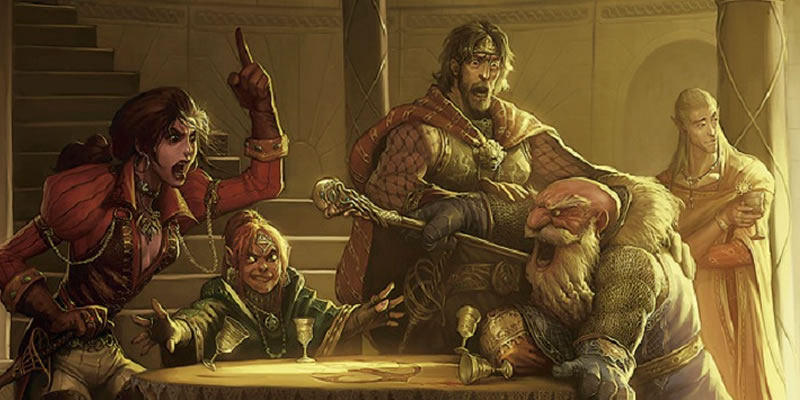PERSONALITY TRAITS, IDEALS, BONDS, FLAWS
Hail and well met, nerds! It’s been a while since the last installment of Dungeons & Dragons Character building, which means you should almost have a complete character! Yes, that’s mostly a joke. Today we’ll cover the final necessary bits of the character sheet: Personality Traits, Ideals, Bonds, and Flaws.
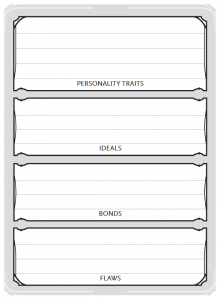
There are two methods for discovering these final four factors about your beloved character:
1.) Refer to your chosen Background, which we discussed here, and found on pg. 118 of the Handbook.
2.) Make up your own!
USING THE BOOK
On your chosen Background’s page in the handbook, you will find four lists for these four different qualities. If you want to really shape your character and stay in complete control, choose your favorites from each list to represent them. If you want to be old school, grab the appropriate dice (listed at the top of the list in the Handbook), and let fate describe your crafted adventurer. But first, let’s discuss what each of these four components represents for your character.
RUN DOWN
Personality Traits: these are the quirky factors that make your character unique. There are plenty of Orc Rogue Charlatans out there (this is a lie – this character does not exist), but not a single one with the same personality traits. From this list, you’ll choose two. Ex: I’ll settle for nothing less than perfection or I always know how things work and what makes people tick.
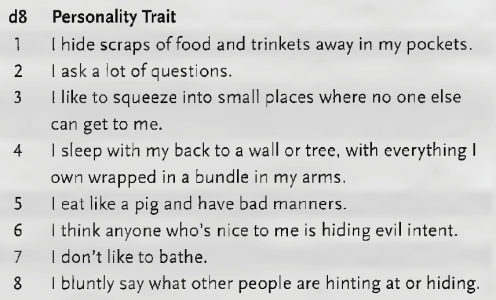
Ideals: these are what drives your character on a moral or ethical level. So not necessarily the reason they get up in the morning, but a factor that influences most of their decisions. Ideals vary from the other three components in that they are expected to be influenced slightly by your character’s alignment. In the Handbook, you will see each option is coupled with one of these markers: law, chaos, good, evil, and neutrality. If you want to play true to your alignment, this might aid in your decision making. Ex: (Charity) I steal from the wealthy so I can help people in need or meddling in the affairs of others always causes trouble.
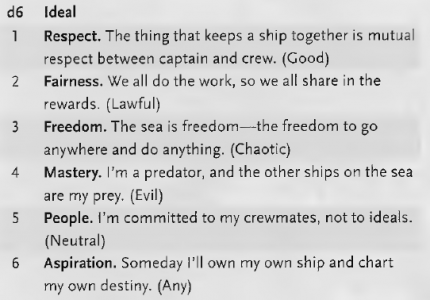
Bonds: these represents your character’s connection to a person, place, event, or thing. This bond can heavily influence how your character treats others, what they find important, or how much stock they put in things. Ex: I will face any challenge to win the approval of my family or someone saved my life on the battlefield; to this day, I will never leave a friend behind.
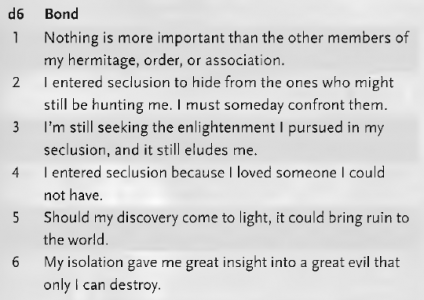
Flaws: Oh, these are so fun. If you’re searching for a way to add a funny tidbit to your character, now’s your chance. These represent a vice, compulsion, fear, or weakness. Flaws can be the thermal exhaust port in the Death Star that is your character. Your Half-Orc Warrior could be practically invincible, unless it is discovered they are helplessly ticklish. Ex: I’d rather eat my armor than admit I am wrong or hearing the word “henchman” causes me to laugh uncontrollably.

MAKING YOUR OWN
Because, as humans, we have each of these four qualities as well, it’s actually very easy to make up your own. Everyone has their unique trait, ideal, bond, and flaw in their own lives, so inspiration for these can be found in yourself, in your parent, in your favorite celebrity, or even your dog. To create these for yourselves, just have your character attempt to answer the following questions associated with each component:
Personality Trait: What completely sets me apart from the rest of the world?
Ideal: What do I believe?
Bond: What’s my motivation?
Flaw: What stops me?
I would consider these four choices to be one of the most fun parts of building your character, especially if you really want to flush out your character’s backstory or personality. Have fun with these decisions, get to know your character, and with your better understanding of who they are, strategize on how best to play to their strengths (and weaknesses).
NEXT TIME
Congratulations! Your character is finally finished! All that’s left are some optional tasks, such as writing a backstory, making some character art, and telling all of your friends about this beautiful creation. The next lesson will be all about spells! Picking them, using them, and making your DM fear your decisions. Keep adventuring, nerds!

